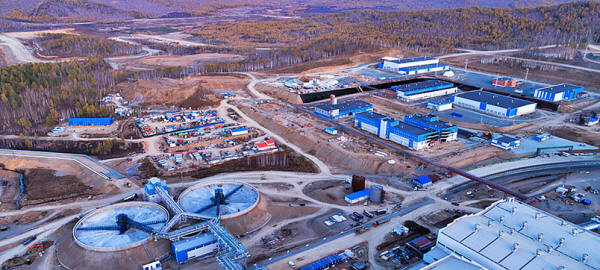|
Notable about the project is the participation of China, as well as the fact that four years ago the huge copper, gold and magnetite reserves of Bystrinsky were inaccessible to any market and completely undeveloped.
It's one example of the
transformation of the entire economic geography of Eurasia that's
growing as a result of the close cooperation of Russia with China
and especially with
China's Belt Road Initiative,
earlier known as the New Economic Silk Road.
The huge project is jointly owned by Norilsk Nickel, the world's largest producer of nickel and palladium and one of the largest producers of platinum and copper, along with CIS Natural Resources Fund, a Russian natural resources fund established by Vladimir Potanin, and by China's Highland Fund.
The new mine complex is
some 400 kilometers by rail from the China border in Russia's
Siberian Far East.
China's Belt, Road Initiative (BRI) that is seeing the construction of thousands of kilometers of new high-speed rail lines across Eurasia is creating a huge increase in demand for copper as well as steel and iron ore.
The new Russian mining project includes construction of entirely new infrastructure of roads, rail spurs and enormous infrastructure in what was previously untouched wilderness.
The mine, the largest
private project in Russia's Far East, will reach full capacity in
2019.
The new bridge will connect China with Russia in the far northeast of China in the region of Harbin.
To have an idea of the
vast distances across the largest country in the world, the Russian
Federation, the Amur River Bridge is some 1000 kilometers east of
the new China-Russia copper mining complex near Chita.
A main immediate benefit of the new bridge will be economical transport of iron ore from the Kimkan open-pit mine in the Jewish Autonomous Oblast that is owned by IRC Limited of Hong Kong.
The rail section will
have both a standard gauge (1435 mm) track and a Russian gauge (1520
mm) track and a two-lane roadway for cars and truck transport.
The Bridge will tie into the China mammoth Belt-Road Initiative by enabling transportation integration into the China-Mongolia-Russia Economic Corridor (CMREC) of the New Economic Silk Road.
The Amur bridge will connect Heihe and the Russian Far Eastern city of Blagoveshchensk, the administrative center of Russia's Amur Oblast where the Amur and Zeya Rivers meet.
The Bridge will then make
a connection to the Russian Trans-Siberian Railway and on to
Vladivostok, the major Russian commercial port on the Pacific Ocean.
...agreed to create a China-Mongolia-Russia Economic Corridor (CMREC) which has become one of the six priority corridors of China's Belt-Road Initiative, the first multilateral cooperation plan to form part of the Belt and Road Initiative.
The CMREC will connect China's Belt and Road Initiative with Russia's proposal for a Eurasian Union and Mongolia's Steppe Road program, promoting regional economic integration.
The CMREC has two key traffic arteries:
...to widen services trade, and cooperation in,
This promises a major
transformation to the three country region that during the tensions
of the Cold War was severely underdeveloped and mutually isolated.
China's Vice Premier Wang Yang said that the investments would target,
This follows a July, 2017 visit of Xi Jinping to Moscow where the two countries signed a series of economic cooperation agreements including creation of a new US$10 billion China-Russia RMB Investment Cooperation Fund, which will give access to RMB financing for Russian projects, including under both the One Belt, One Road and Eurasian Economic Union initiatives.
One project in China's Hainan calls for a $500 million (RMB equivalent) investment to develop,
...as priority areas.
Hainan is a main portal
of the China Maritime Silk Road infrastructure.
The development involves
Russian state-owned corporation
Rostec Corporation as one of the
key tenants, and Russian investment company Vi Holding as a
developer.
The aim of the project is
to promote further growth and export of GMO-free and ecologically
clean Russian agriculture products to the Chinese market.
According to a new study by the Watson Institute of International and Public Affairs at Brown University, Washington has spent a staggering $5.6 trillion on wars in,
...since 2001, more than
three times what the Pentagon has claimed in official estimates.
They might even imagine
peaceful cooperation in the emerging Russian-Chinese Eurasian
development, a true win-win for the world...
|


